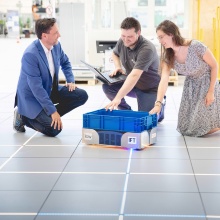What does the mobility of the future look like? How is the industry changing? At Hannover Messe 2022, which takes place from May 30 to June 2, various institutes and research facilities of the University of Stuttgart will present highlights from their research.
FlexCAR vehicle platform, real-time dashboard, and digital wiring harness
Representatives of ARENA2036 present the vehicle platform FlexCAR at the booth of the Federal Ministry of Education and Research (BMBF). The prototype is about two by four meters and looks like a car without a body. The modular FlexCAR features open hardware and software interfaces. This allows developers to produce different attachments for the vehicle. They thus are not dependent on an automotive parts supplier and can flexibly develop components with smaller companies as well. This reduces the development effort for new vehicle components. The FlexCAR is a platform for modern mobility. Once the development of the prototype is complete, it will bridge the gap between the real world and virtual reality. For new vehicle concepts, researchers will not have to build haptic prototypes every time. Instead, they can view the models in virtual reality. At the University of Stuttgart, the Institute of Human Factors and Technology Management (IAT), the Institute of Automotive Engineering (IFS), the Institute of Aircraft Design (IFB), and the Institute of Electrical Energy Conversion (IEW) are participating in the project.
At the Baden-Württemberg International booth, a partner start-up of ARENA2036 will show their project “Peakboard”, which is a visualization option for corporate data. The start-up develops real-time dashboards on which important information (e.g., data from a production hall) converges and is visible at a glance.
Among other things, the Platform Industry 4.0 booth will feature the “Management Shell for the Line Set” [de] (VWS4LS; Verwaltungsschale für den Leitungssatz) project. In this project, researchers want to cast the wiring harness in the car into a kind of digital twin. With the help of the digital management shell, process steps can be automated. At the trade fair, exhibitors will show a spread-out cable harness, which visitors can use to see all cables installed in a car.
Networked mobility
The Innovation Campus Mobility of the Future (ICM) of the University of Stuttgart and KIT will show a model of a single-seater for small, efficient city vehicles in the Baden-Württemberg Pavilion. This serves as an experimental vehicle for testing novel technologies such as additive manufacturing, lightweight construction with fiber materials, and new types of drive components. Such vehicles will also contribute to networked mobility in autonomous car-sharing fleets.
The ICM will also present a conveyor belt demonstrator of the partner ITIV. This enables the presentation of realistic traffic scenarios with model vehicles on a scale of 1:14. With the help of sensors, the vehicles can recognize their surroundings and react to them.
Contactless electrical power transmission
The Institute of Electrical Energy Conversion (IEW) focuses on two main research areas: electrical machines and contactless power transmission. The scientists are researching the design of electric motors with high torque density and position-tolerant inductive charging systems.
This year at Hannover Messe, the IEW is exhibiting a rotating inductive transformer that can be used for contactless electrical power transmission in rotating systems. The IEW researchers designed the transformer to be used in an electrically excited synchronous machine. With a peak power of 120 kilowatts, this is ideal for use in a compact electric vehicle. The inductive rotating transformer consists of two rotating coils, a full bridge on the primary side, and an active Royer rectifier on the rotating secondary side. The coil system has been designed to be seamlessly integrated into the hollow shaft of the electric motor, thereby saving space. With a transmission frequency of 350 kHz, an efficiency of up to 95% can also be achieved. Thanks to the absence of contact during the transmission of electrical energy, the inductive rotating transformer is both low-maintenance and low-noise.
Reconfigurable (real-time) applications
At Stand F54 in Hall 5, the Institute for Control Engineering of Machine Tools and Manufacturing Units (ISW) at the University of Stuttgart will present the FabOS research project, which is funded by the German Federal Ministry for Economics and Climate Affairs (BMWK). The reconfigurable (real-time) applications exhibit focuses on the special case of service commissioning in real-time capable TSN (time-sensitive networks). Here, with the help of the management shell, the communication information of an application is described and taken into account during commissioning. This includes deriving scheduling specifications for the TSN interfaces in the local network.
| Contact |
|
|---|


